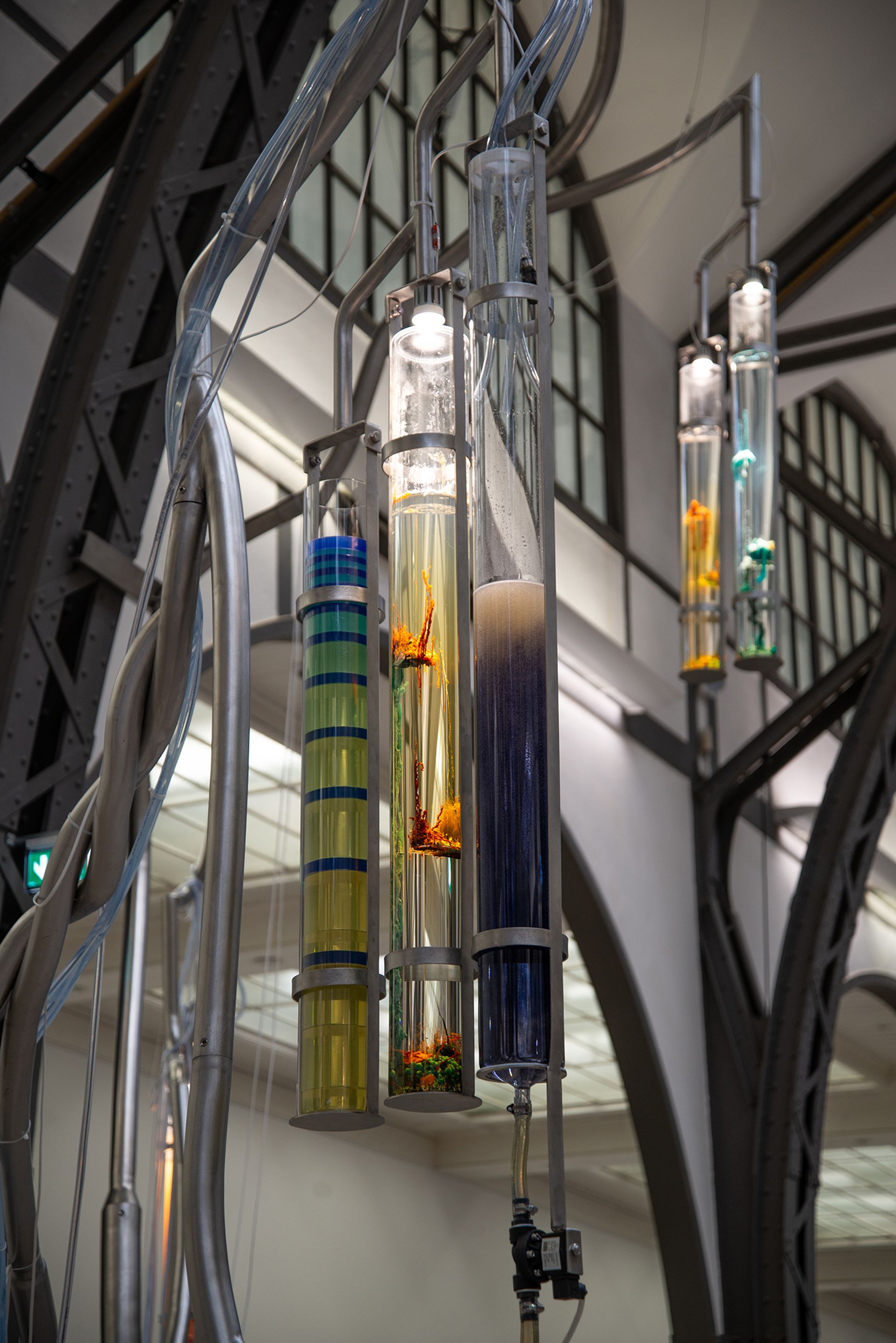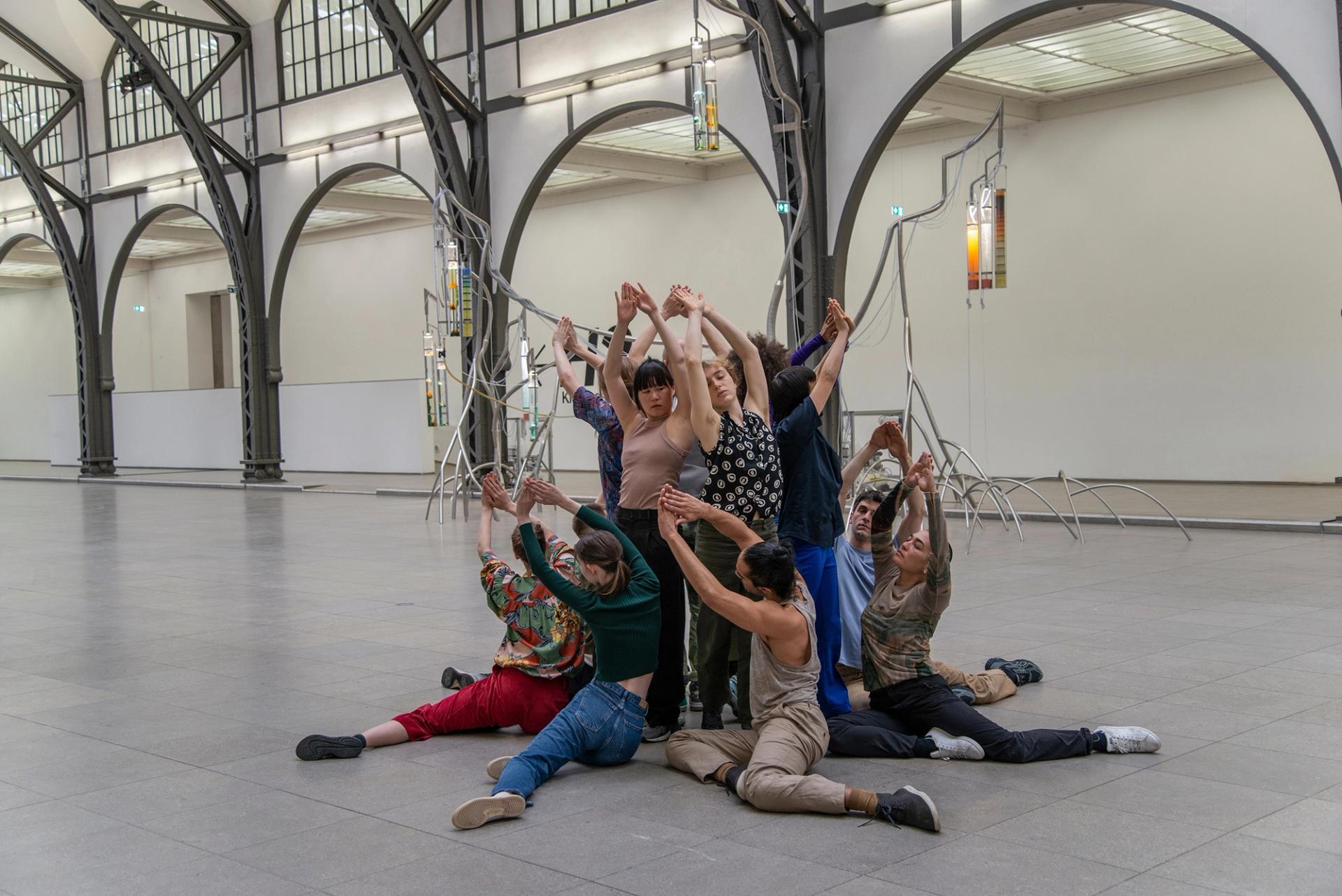For the next five months, the artist Alexandra Pirici has turned the vast central hall of Berlin’s Hamburger Bahnhof into a cross between a science experiment, a landscape and a choral performance. Her latest large-scale live work, titled Attune, opened last week at the contemporary art museum ahead of Gallery Weekend Berlin, co-commissioned by Audemars Piguet Contemporary, the art commissioning programme of the Swiss luxury watchmakers, and co-funded by the German Federal Cultural Foundation.
A trained dancer, Pirici made her name with “live sculptures” in which she choreographs groups of performers to act out a dizzying variety of concepts using only their bodies. Her breakout 2013 exhibition, An Immaterial Retrospective of the Venice Biennale, took over the Romanian pavilion of that year’s Biennale with physical re-enactments of more than 100 works of art from the event’s history, from Picasso to Maurizio Cattelan. Leaking Territories, made for Skulptur Projekte Münster in 2017, saw performers answering random questions from the audience like a “human search engine”. Encyclopedia of Relations, a previous collaboration with Audemars Piguet Contemporary for the 2022 Venice Biennale, dissected the very idea of interaction, not only between humans and technology but among other entities, including plants and animals, rocks and waves.
Humanity’s coexistence with other lifeforms—and with non-living things on the planet—is centre stage in Attune. Speaking at a press conference, Pirici described the new work as a “celebration” of the “continuum” between the living bodies who will move collectively through the Hamburger Bahnhof hall and the “lifelike” behaviour found in inanimate matter. She said she was “interested in expanding the range of what can perform and what can be active”.

Pirici's "chemical gardens” hanging in outsized test tubes Courtesy of the artist and Audemars Piguet
For four hours every afternoon until October, Pirici’s cast of human performers will dance, crawl, sing, recite and gather together at the museum. But Attune also involves a series of inanimate elements that are expected to perform in their own way, including a sand dune and a cluster of “chemical gardens” hanging in outsized test tubes from a sprawling metal structure. These colourful mineral growths, evoking the tendrils of coral or algae, are created by dropping metal crystals into a solution: an experiment that has fascinated chemists since the 17th century.
Pirici wants to make visible the self-organising patterns in inorganic materials that have been found by modern science. Borne by the wind, grains of sand coalesce into dunes. A mix of colourless solutions produces a dramatically oscillating chemical reaction between dark blue and amber. Pirici has collaborated with chemists at the Freie Universität Berlin and University of Bucharest to scale up the Briggs-Rauscher Reaction for a few public “performances” as part of her exhibition.

Inanimate elements, such as a san dune, are expected to perform in their own way Courtesy of the artist and Audemars Piguet
The research for Attune draws from biochemistry, molecular biology and physics as well as more “poetic” sources, she tells The Art Newspaper, like the author Ursula K. Le Guin’s 1985 sci-fi novel Always Coming Home. Another starting point was the idea of choreographing a “duet” between a human body and a stone, the living with the non-living. “There need not be a distinction between scientific facts and beautiful stories and metaphors,” she says.
Pirici likens the installation to “a landscape or a small piece of a fictional planet” for visitors to roam around freely, and the live performances also take inspiration from the natural world. At moments in the show the performers’ actions evoke the spiralling leaves of an aloe plant, the synchronised flashing of fireflies in the dark (the group waves their phone lights in harmony in an experience familiar to any concert-goer) and the murmurations made by starlings swooping together through the sky.
Their voices, too, mimic the whistling of birds. The title “Attune” has a deliberately musical connotation, as Pirici has composed a number of polyphonic songs for the performance that echo through the cavernous space. She describes the feat of achieving harmony through a multitude of melodies as a metaphor for a pressing political challenge: to “find a common ground” in the midst of division. “It’s interesting to think of the art institution as a space for a new kind of gathering and singing together,” she says.

Alexandra Pirci's Attune (2024). Courtesy of the artist and Audemars Piguet
In the age of climate emergency, there is an ecological message underlying it all, “about interconnectedness, and how we are basically part of the same world and fabric”. Ultimately, Pirici hopes to inspire viewers with “an extended appreciation of the material world” and of humanity’s “non-exceptional” status on the planet, she says in a recent interview, published in the exhibition catalogue.
Although Attune invites Berliners to linger and return to the work repeatedly for the show’s five-month run, it will be an ephemeral presence in the museum, like all of Pirici’s durational live works. But there is a chance that in future she will have a permanent base for her hybrid experiments between performance, philosophy, science and nature. Her “dream”, she says, would be to create her own public art space in Europe, a kind of “performative sculpture garden”. Expanding on the sci-fi storytelling of Attune, she imagines it as a place where “people could perform alongside plants” or other “more-than-human elements”.
• Alexandra Pirici: Attune, until 6 October 2024, Hamburger Bahnhof – Nationalgalerie der Gegenwart, Berlin. Live action daily from 1pm-5pm, Thursdays from 3pm-7pm. The Briggs-Rauscher Reaction can be experienced between 1.30pm-2pm and 4-5pm from 26-30 April.


